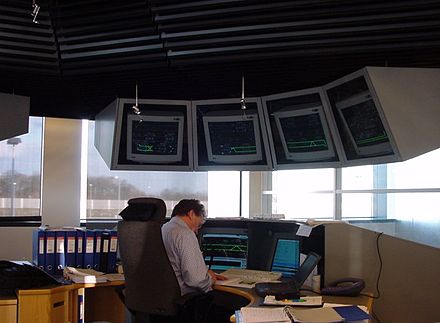
Véhicule Automatique Léger, or VAL is a type of automatic rubber-tyred people mover technology, based on an invention by Professor Robert Gabillard from the Université Lille Nord de France. It was designed in the early 1980s by Matra and first used for the then-new Lille Metro system. This was one of the world's first fully automated driverless mass-transit rail networks to serve a city centre, and the first such in Europe.
The Copenhagen Metro is a 24/7 rapid transit system in Copenhagen, Denmark, serving the municipalities of Copenhagen, Frederiksberg, and Tårnby.
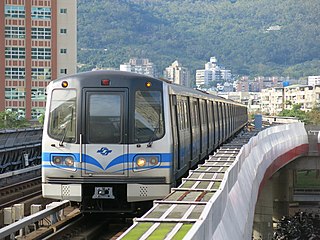
Taipei Mass Rapid Transit (MRT), branded as Taipei Metro, is a metro system serving Taipei and New Taipei, Taiwan, operated by government owned Taipei Rapid Transit Corporation, which also operates Maokong Gondola.

The Rome Metro is a rapid transit system that operates in Rome, Italy. It started operation in 1955, making it the oldest in the country.
Hitachi Rail Italy S.p.A. (HRI) is a rail transport engineering company based in Italy whose main products are the design and manufacturing of railway and mass transit vehicles. Formerly AnsaldoBreda S.p.A., a subsidiary of Finmeccanica, the company was sold in 2015 to Hitachi Rail along with the 40% share of Ansaldo STS that Finmeccanica owned. After the deal was finalized, the current name was adapted in November 2015 to reflect the new ownership.

The Milan Metro is the rapid transit system serving Milan, Italy, operated by Azienda Trasporti Milanesi. The network consists of 4 lines, identified by different numbers and colours, with a total network length of 96.8 kilometres (60.1 mi), and a total of 106 stations, mostly underground. It has a daily ridership of about 1.4 million on weekdays.

Automatic train operation (ATO) is an operational safety enhancement device used to help automate operations of trains. This is achieved according to the Grade of Automation (GoA) present, up to GoA 4 level, where the train is automatically controlled without the presence of staff on board. ATO is primarily used on automated guideway transits and rapid transit systems which are easier to ensure safety of humans. Most systems elect to maintain a driver to mitigate risks associated with failures or emergencies.
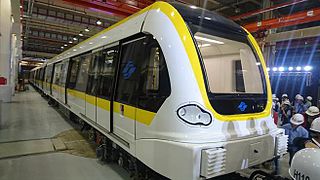
The Circular or Yellow line is a metro line under construction in Taipei. Phase I of the project consists of the section from New Taipei Industrial Park to Dapinglin and is approximately 15.4 km (9.6 mi) long with 14 stations. This initial section was scheduled to open on 16 June 2018, but has been delayed until Q4 2019. As of November 2019, the project is 99.42% finished. AnsaldoBreda will supply 17 four-carriage medium-capacity trains for the line. The line is planned to be operated by Taipei Rapid Transit Corporation.

M1 of the Copenhagen Metro, colored green on the map, runs from Vanløse to Vestamager. It connects the Ørestad neighborhood of Copenhagen, Denmark, to the city center. The line is elevated while traveling through Ørestad, while it runs in a tunnel below the city center. From Christianshavn to Vanløse, the line is shared with M2.
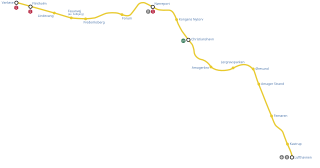
M2 is a line of the Copenhagen Metro, colored yellow on the map. It runs from Vanløse to Lufthavnen through the center of Copenhagen, sharing track with the M1 from Vanløse to Christianshavn. The line was built along with M1 as part of the redevelopment of Ørestad. The principle of the line was passed in 1992, and construction commenced in 1998. The line opened in several stages between 2002 and 2007. It is owned by Metroselskabet and operated by Metro Service, and operates with a headway between four and twenty minutes.

Platform screen doors (PSDs) and platform edge doors (PEDs) at train or subway stations separate the platform from the train. They are primarily used for passenger safety. They are a relatively new addition to many metro systems around the world, some having been retrofitted to established systems. They are widely used in newer Asian and European metro systems.

The City Circle Line or M3 is a loop line of the Copenhagen Metro. It has been claimed by COWI A/S that the City Circle Line is the largest construction project to have taken place in Copenhagen during the last 400 years. The network's total length is 15.5 kilometres (9.6 mi) and has 17 stations. The line opened on 29 September 2019.
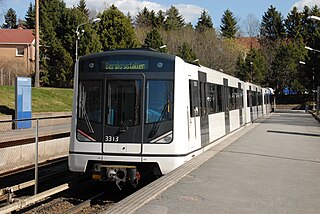
MX3000 is an electric train used on Oslo Metro in Oslo, Norway. The multiple units are produced by Siemens, who started serial delivery in 2007. Seventy-eight three-car units have been ordered by Sporveien, and five by Akershus County Municipality. They replaced the older T1000 and T1300 stock that was used on the Oslo Metro since 1966. By 2010, the last T1000 and T1300 trains have been retired and replaced by 83 three-car units. 32 additional sets were ordered, and the final train set was delivered in 2014, increasing the fleet to 115 units.

Incheon Subway Line 2 is a 27 station subway line 29.2-kilometer (18.1 mi) from Oryu-dong in Seo-gu to Incheon Grand Park., part of the Incheon Subway system. The line is also included as a part of the overall Seoul Metropolitan Subway network; Juan Station has a free transfer with Seoul Subway Line 1, Geomam Station connects with the AREX Line to Incheon International Airport and Seoul Station, and Seongnam will eventually have a free transfer with Seoul Subway Line 7.

The Brescia Metro is a light metro network serving Brescia, Lombardy, Italy. The network comprises a single line, having a length of 13.7 kilometres (8.5 mi) and a total of 17 stations from Prealpino to Sant´Eufemia-Buffalora, located respectively at the north and southeast of Brescia.

The Siemens Modular Metro is a family of electric multiple unit trains for rapid transit systems produced by Siemens Transportation Systems and used by rail operators around the world. The vehicle concept was launched in Vienna in 2000 and is a modular concept allowing many variants of metro vehicles. Previously known as Modular Mobility, Siemens, whose rail equipment division has been renamed Siemens Mobility, still uses the abbreviation Mo.Mo; however, these trains are no longer being made, having been replaced by Siemens's new Inspiro family of metro trainsets.
Hitachi Rail STS is an Italian transportation company owned by Hitachi with a global presence in the field of railway signalling and integrated transport systems for passenger traffic and freight operations. Hitachi Rail STS plans, designs, manufactures, installs and commissions signaling systems, components and high technologies for the management and control of newly built or upgraded railways, transit and freight lines worldwide.
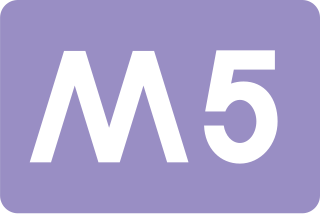
Line 5 is a 12.8-kilometre (8.0 mi) underground light metro line in Milan, Italy. The line is part of the Milan Metro and serves the north-eastern part of the city. Line 5 opened in stages between 2013 and 2015

The Meneghino is an electric multiple unit manufactured by Italian companies Firema and AnsaldoBreda. Meneghino was specifically designed for the Milan Metro, hence its name, which means of Milan in Italian.


